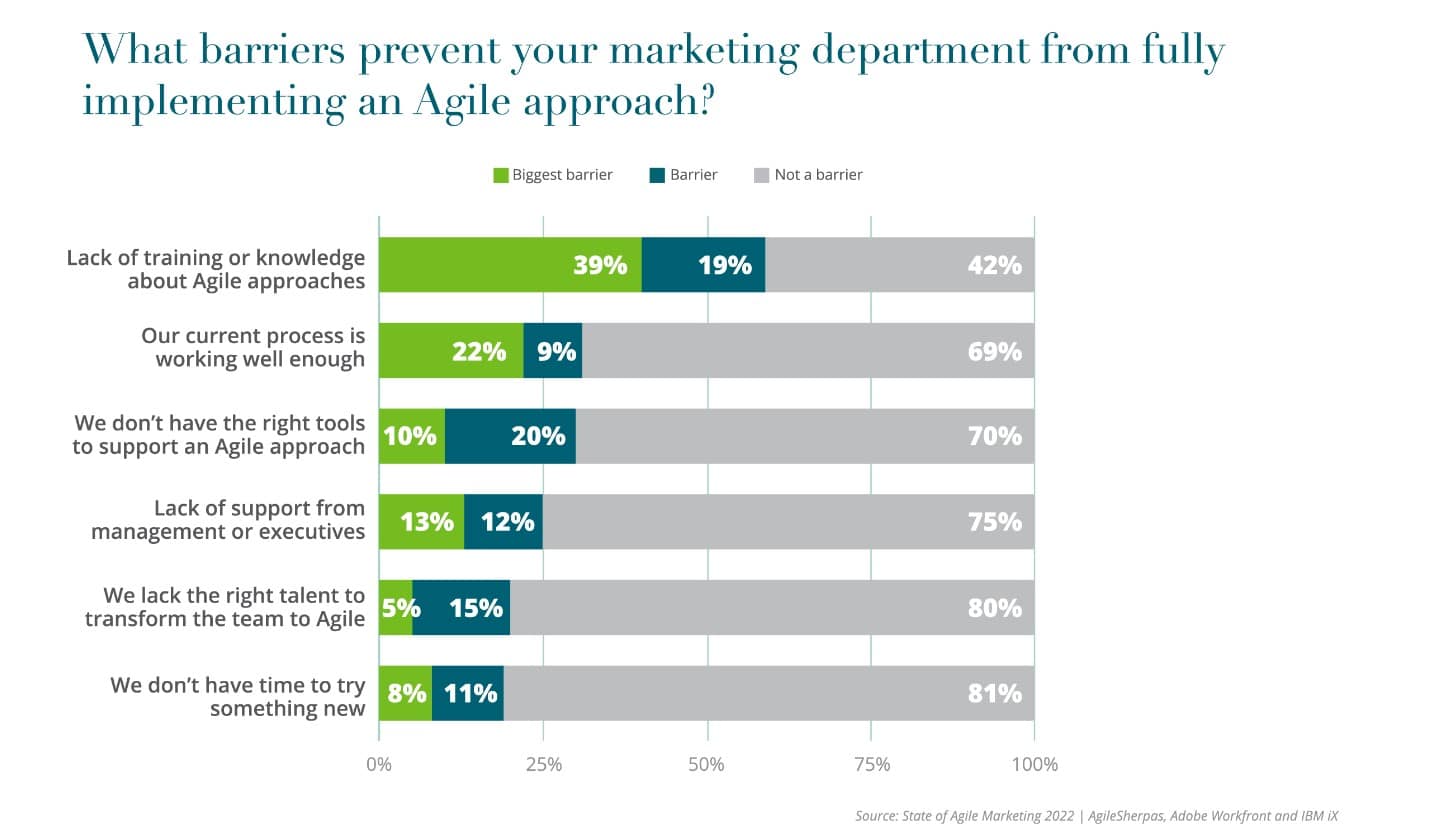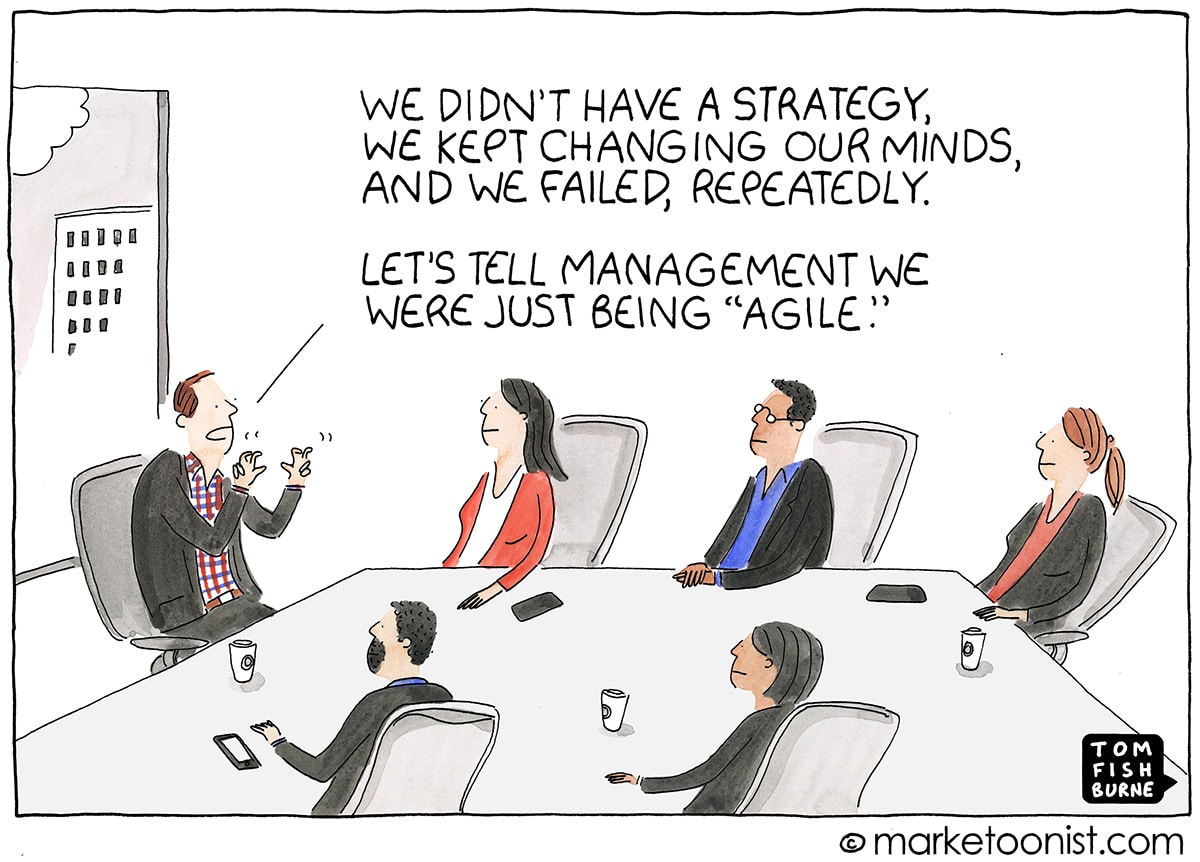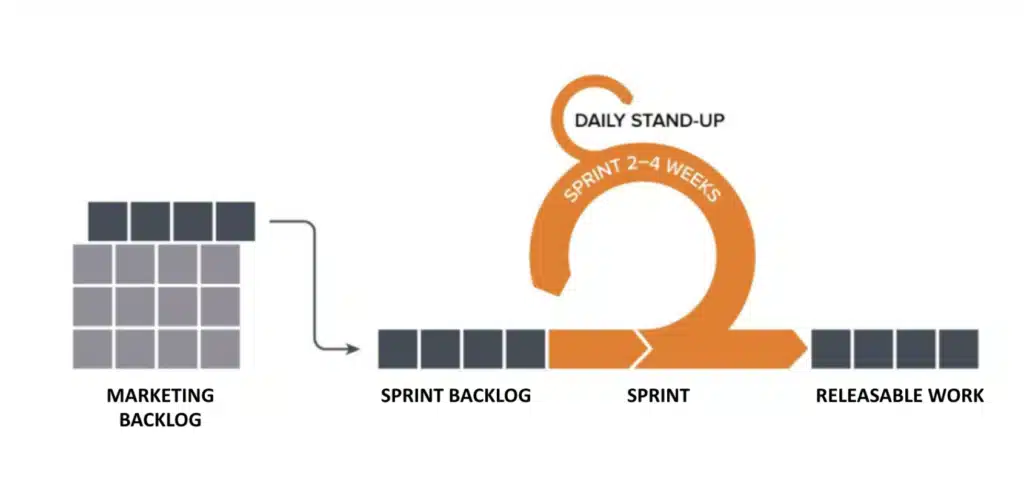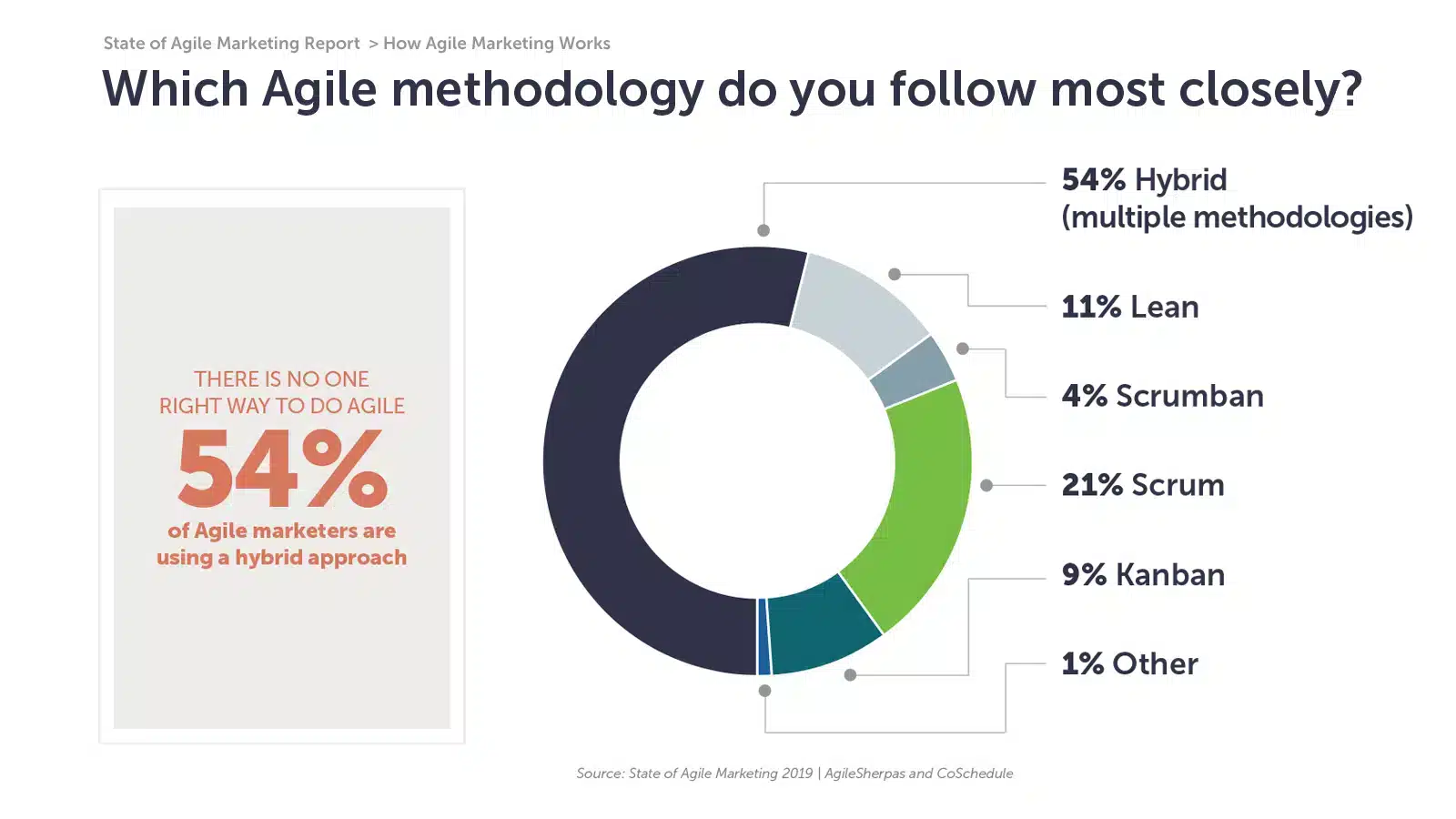
What Is Agile Marketing? Everything You Need To Know
There’s a lot of hype around Agile marketing, which might make the subject seem daunting. Don’t know where to start? (Hint: you’re in the right place!)
The framework brings with it a set of terms, tools, and tactics that are unfamiliar to many marketers. Usually, newcomers are at the main disadvantage since they have yet to work on dedicated Agile teams.
As proof of that point, recent studies show that only half of marketers have used Agile. Often, a lack of knowledge stands in the way of adopting the philosophy.
So, just what is Agile marketing anyway, and why is it still vital for our field?
Dive in to discover your own path to agility because it’s not just a buzzword. Learn why Agile is a fundamentally better way of working for all marketers.

Image Source: AgileBusiness.org
Key Takeaways:
- Agile marketing facilitates quick and responsive marketing that achieves higher levels of success.
- Agile marketing works by focusing on key principles instead of rigid practices.
- Hybrid frameworks work best for agile marketing.
- Agile marketing can’t fix broken campaigns or teach you how to be a good marketer, but it can make you better if you have a good foundation.
What Is Agile Marketing Anyway?
The Agile methodology is a strategy where you focus on high-value projects and take quick, smaller actions to get practical data on how to proceed. Software developers created the Agile philosophy at the turn of the millennium.
In simple terms, it’s a way to do less work and get more done. That sounds grand, doesn’t it?
However, such a fundamental shift in the way you work can require a dramatic transformation. Let’s go a little deeper into the weeds.
Agile Marketing Misconceptions
You may have heard many misinterpretations of agile, raising the question: What is not Agile marketing?
Old-school marketers (and businesspeople in general) like to fall back on the waterfall approach of management. This method typically involves planning everything out for the upcoming year.
As a result, these folks might view agile practices as not strategizing or changing direction on a whim. However, Agile is not:
- A failure to plan
- Just speed
- Just Scrum

Image Source: Marketoonist.com
Also, Agile is not simply newsjacking or succeeding once or twice with a bright idea on social media.
For example, Oreo’s team made a brilliant decision to respond to the power outage at Super Bowl XLVII with a cheeky tweet.
A large portion of the 108.7 million viewers rushed to their smartphones to figure out what was going on. At that point, many saw Oreo’s humorous take on the situation.
It was awesome and agile (lowercase a), but it’s not Agile (capital A).
An Agile team might have produced that Oreo tweet. However, a traditional team having a great moment of inspiration could have done the same.
So what is the Agile marketing difference?
Principles Over Practices
The biggest changes around Agile marketing happen at the level of process, workflow, and operations. Instead of sticking rigidly to a rulebook of practices, Agile teams follow guidelines that keep them adaptable.
The result is that Agile marketing teams release campaigns, content, and other marketing output quickly as a general practice, not a one-off response. Their work will be more open to iteration than a traditional huge Big Bang campaign.
Forward-thinking marketers eventually updated the original Agile values for a Marketing Manifesto that includes:
- Focusing on customer value and business outcomes over activity and outputs
- Providing value early and often over pushing for perfection
- Learning by data and experimentation over opinions or tradition
- Collaborating freely over following hierarchies and siloes
- Responding to change over sticking to a static plan
These principles represent the real revolutionary power of Agile ways of working.
As a result, you don’t need to design diagrams and charts with hundreds of rows and columns. Just get the right people together and allow them to hash out solutions to problems.
Of course, you don’t eliminate concern over activity, outputs, plans, effective traditions, or well-founded opinions. Still, when push comes to shove, you default to the guidelines above in bold.
What is the Agile Marketing Manifesto, and what are other ways you can apply it? Find out more in the following video.
No Prescriptive Practices
The Manifesto goes on to outline a dozen Agile principles. You might feel pressure to turn these fundamentals into rules, ruining what makes Agile so great.
Bear in mind, nowhere in the document does it decree, “Thou shalt have two-week sprints” or “Thou shalt stand up for 15 minutes every day.”
Practitioners have developed practices like Scrum-based sprints and daily standup meetings to bring these principles to life, but they aren’t the only options. You don’t have to execute a carbon copy of Agile software development.
There are tons of ways to do Agile, so develop your own system. As long as you base it on the key values and principles, it’s Agile.
Which Framework Should You Use?
This flexibility can be empowering for marketing teams seeking an Agile approach. Still, it also means you have to spend more time upfront learning about the available options.
What is the Agile marketing framework that works best? You likely won’t be using a single framework but rather a hybrid of two or more, so you have to know about them all.
Here’s an overview of the two most common frameworks, plus thoughts on blending them successfully.
Kanban
The Kanban framework is all about flow. The system continually delivers value to a customer and does so by creating visibility and focus.
Visibility
Visibility comes through the well-known Kanban board, which includes vertical columns that represent stages of work. At its simplest, these stages can be “To Do, Doing, Done.”
The board can get more complex to fit additional steps for involved assignments and larger teams, such as content marketing. Consider the example below:

Image Source: AgileSherpas.com
The point of a board is simple: show what a team is working on. Once you know where the effort is going, you can decide if those are the right places to concentrate.
Focus
You can then create focus by applying Work in Progress limits. These WIP hard ceilings place limitations on how many items can be in a particular stage of work (e.g., only 5 things in “Content Review” on our sample board).
What is Agile marketing with Kanban’s key advantage for focus?
No matter what anyone tells you, humans are terrible multitaskers. When you have fewer things in progress, everything gets done much faster (despite popular belief).
Kanban includes more than just a board and WIP limits, but these two are plenty to get you started. Over time, you can incorporate more practices as you mature in your use of the framework.

Image Source: MarketingInsiderGroup.com
Scrum
While Kanban provides continuous flow, Scrum focuses more on recurring incremental delivery.
Use of Sprints
Scrum uses short sprints, or bursts of focused work, to concentrate on high-value tasks and remove distractions. However, the system creates this focus through timeboxing rather than hard limits on work in progress.
Each sprint requires the team to decide how much they think they can accomplish from their prioritized to-do list (or backlog). The team then commits to completing that within the next few weeks, which is the “sprint.”
Ideally, the team focuses only on those items until the sprint is over, resulting in a valuable piece of work.

Image Source: MarketingProfs.com
Meetings
The team manages the Scrum process through meetings. What is the Agile marketing meeting lineup?
- Sprint Planning: Outline upcoming work and commit to completing it as a team.
- Daily Standup: Assess everyone’s progress each morning, determine what blocks are holding you back, and decide how to help one another succeed.
- Sprint Review: Do a demo or show-and-tell for people outside the team to see what you’ve accomplished during the sprint.
- Sprint Retrospective: Review your process over the past few weeks and identify areas for improvement.
With Scrum, meetings must remain brief, or your team loses agility.
Roles
Scrum also has very clearly defined roles within the process:
- Scrum Master: Owns the process, including facilitating meetings and managing interpersonal relationships within the team
- Product Owner: Focuses on a single team and makes sure the group is doing the right work at the right time
- Team Members: Work together for mutual success with little to no hierarchy
Scrum requires you to know what a full weeks-long sprint will look like. If you can’t specify your workflow that far out, stick with Kanban or use a hybrid format.
Hybrid Alternatives
What is an Agile marketing hybrid strategy? Simply put, find a practical recipe for mixing Scrum, Kanban, and other strategies (leading to the now-popular Scrumban strategy).
Scrum is more prescriptive, so it can feel comforting to teams with no experience using Agile. On the other hand, Kanban is more adaptive, allowing you to start by visualizing your current process and moving on from there.
Time has shown that most marketers are using a hybrid of some kind. In fact, marketers are more than twice as likely to use a hybrid approach as they are to use Scrum.

Image Source: AgileSherpas.com
So don’t be afraid to try sprints with a board and WIP limits inside them. Or use Kanban and add in regular review meetings.
(Actually, Kanban rarely seems to work without the 15-minute check-ins and regular retrospectives that are common to Scrum.)
There are an infinite number of variations, so don’t be afraid to experiment and build your own hybrid. If you need more advice on blending the models, watch this breakdown:
How Do You Get Started With Agile Marketing?
Moving to Agile marketing can feel overwhelming, especially if you aren’t a CMO with the right to sweepingly reform the process of an entire department. What is your Agile marketing entry point?
Start with three easy steps to begin an ideal hybrid model:
- Build a backlog: A backlog is your strictly prioritized to-do list. You (or your team) use it to identify the highest-value work to do next. Remember to update it often; otherwise, you risk working on unproductive assignments.
- Visualize your work: In other words, build a Kanban board. If the board is just for you as an individual, start with “To Do, Doing, Done” as your columns. If you’re using it for a team, consider the different phases work passes through and the required handoffs to complete jobs.
- Apply WIP limits: Create hard limits on how much you can work on at a given time. A WIP limit of two per individual is often ideal. The point is to create focus and force everyone to stop starting new things and start finishing what they’re working on.
Finally, plan for regular touchpoints to evaluate and improve your process. What is on the Agile marketing meeting timeline?
Teams should plan for a daily standup meeting around the Kanban board. Hold brief retrospective sessions every two weeks.
If you’re a team of one, sit down and review your board every morning with your coffee or tea. Then every couple of weeks, make a list of new improvements you want to try and implement one.
What Are the Limitations of Agile Marketing?
Agile marketing is a powerful force that can improve multiple aspects of a company’s operations. Marketers get better and stick around longer, building better relationships with sales and creating campaigns that encourage strong connections with customers.
Despite all of that positive potential, there are a few critical things Agile marketing cannot do.
Agile Won’t Fix Broken Marketing
Agile marketing cannot turn crappy marketers into excellent ones.
In other words, while Agile brings out the best in capable marketers, it will highlight the flaws of anyone who refuses to embrace the fundamentals of good marketing.
Don’t assume that Agile will solve any and all marketing problems. Marketing cannot work if it’s obsolete and out of sync.
What is your Agile marketing going to require to work well? Before you think about implementing Agile, reinforce the cornerstones of effective marketing:
- Customer-focused: Stop talking about yourself and start solving problems for customers. Your audience doesn’t care about anything else.
- Data-enabled: We need to really know what’s working if we want to keep our jobs. Invest in analytics tools that give you reliable data by tracking the behavior of customers and prospects throughout their buying journey and across all available channels.
- Content-driven: Effective content marketing is the foundation of all successful marketing. You need outstanding content creation abilities to stay in touch with your customers and prospects.
- Persona-powered: You don’t need to spend months and months crafting perfect personas, nor do you need a pristine customer journey map. You do need at least an idea of both those pieces in order to create content that solves real problems for your target audience.
- Choosy about channels: Your audience isn’t on every channel in the world, so you don’t need to be either. Choose your areas of focus carefully and understand that means you won’t be everywhere.
Follow these marketing best practices whether you choose Agile marketing or not. Without them, Agile will just allow you to spin your hamster wheel faster.
Agile Won’t Tell You How To Market
What is Agile marketing able to teach you about marketing? The methodology can only enhance the foundation and skills you already have.
I’ve had multiple people request a level of detail inside Agile marketing case studies that I find disconcerting. These Agile enthusiasts want to know the exact composition of outstanding Agile campaigns.
Demand for that level of detail before they’ll consider trying Agile misses the point of case studies entirely. Hyper-detailed case studies make it far too easy to become paint-by-numbers teams.
Marketing teams need to be true artists that experiment and adapt, not copycat, plug-and-play drones. Besides, even if you execute such a strategy perfectly, you learn nothing.
Case studies aren’t there to tell us how to do our jobs, and they don’t fit our particular situation or place in time.
So don’t try paint-by-numbers Agile marketing. It’s not going to be a pretty picture.
Agile marketing is all about learning, making mistakes, growing, and mastering your craft. It’s equal parts science and artistry and opens the door to delivering your best.
What Is Your Agile Marketing First Step?
Beginning a new process can be tedious and frustrating when you’re a novice. What is an agile marketing strategy that ensures you start on the right foot?
Get a helping hand from a seasoned pro to put you on track quickly and minimize errors. Talk to a specialist at Marketing Insider Group to start devising an agile marketing plan that fits you.







Great post, thanks. Would be great to get this as a whitepaper / PDF 🙂